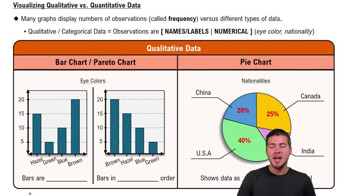A stemplot contains the row 2|0024555789. List the data points displayed in this row.
Table of contents
- 1. Intro to Stats and Collecting Data1h 14m
- 2. Describing Data with Tables and Graphs1h 55m
- 3. Describing Data Numerically2h 5m
- 4. Probability2h 16m
- 5. Binomial Distribution & Discrete Random Variables3h 6m
- 6. Normal Distribution and Continuous Random Variables2h 11m
- 7. Sampling Distributions & Confidence Intervals: Mean3h 23m
- Sampling Distribution of the Sample Mean and Central Limit Theorem19m
- Distribution of Sample Mean - Excel23m
- Introduction to Confidence Intervals15m
- Confidence Intervals for Population Mean1h 18m
- Determining the Minimum Sample Size Required12m
- Finding Probabilities and T Critical Values - Excel28m
- Confidence Intervals for Population Means - Excel25m
- 8. Sampling Distributions & Confidence Intervals: Proportion1h 12m
- 9. Hypothesis Testing for One Sample3h 29m
- 10. Hypothesis Testing for Two Samples4h 50m
- Two Proportions1h 13m
- Two Proportions Hypothesis Test - Excel28m
- Two Means - Unknown, Unequal Variance1h 3m
- Two Means - Unknown Variances Hypothesis Test - Excel12m
- Two Means - Unknown, Equal Variance15m
- Two Means - Unknown, Equal Variances Hypothesis Test - Excel9m
- Two Means - Known Variance12m
- Two Means - Sigma Known Hypothesis Test - Excel21m
- Two Means - Matched Pairs (Dependent Samples)42m
- Matched Pairs Hypothesis Test - Excel12m
- 11. Correlation1h 6m
- 12. Regression1h 50m
- 13. Chi-Square Tests & Goodness of Fit1h 57m
- 14. ANOVA1h 57m
2. Describing Data with Tables and Graphs
Stemplots (Stem-and-Leaf Plots)
Problem 2.T.1d
Textbook Question
The overall averages of 12 students in a statistics class prior to taking the final exam are listed.
67 72 88 73 99 85 81 87 63 94 68 87
d. Display the data in a stem-and-leaf plot. Use one line per stem.
 Verified step by step guidance
Verified step by step guidance1
Step 1: Understand the stem-and-leaf plot. A stem-and-leaf plot is a way to organize numerical data by separating each value into a 'stem' (all but the last digit) and a 'leaf' (the last digit). For example, the number 67 would have a stem of 6 and a leaf of 7.
Step 2: Identify the range of the data. The smallest value is 63, and the largest value is 99. This means the stems will range from 6 to 9 (representing the tens place).
Step 3: Create the stems. Write down the stems (6, 7, 8, and 9) in a vertical column, each on its own line. These represent the tens place of the numbers.
Step 4: Assign the leaves to their respective stems. For each number in the data set, write the last digit (the leaf) next to the corresponding stem. For example, for the number 67, write the leaf 7 next to the stem 6. Repeat this for all numbers in the data set.
Step 5: Organize the leaves in ascending order for each stem. Once all the leaves are assigned, sort them in increasing order for each stem to make the plot easier to read. For example, if the leaves for stem 6 are 7, 3, and 8, rearrange them as 3, 7, 8.
 Verified video answer for a similar problem:
Verified video answer for a similar problem:This video solution was recommended by our tutors as helpful for the problem above
Video duration:
2mPlay a video:
Was this helpful?
Key Concepts
Here are the essential concepts you must grasp in order to answer the question correctly.
Stem-and-Leaf Plot
A stem-and-leaf plot is a method of displaying quantitative data in a graphical format, similar to a histogram, that helps visualize the distribution of the data. Each number is split into a 'stem' (the leading digit or digits) and a 'leaf' (the trailing digit). This format retains the original data values while providing a clear view of the data's shape and distribution.
Recommended video:

Creating Stemplots
Data Organization
Organizing data is crucial for effective analysis and interpretation. In the context of a stem-and-leaf plot, data must be sorted in ascending order to accurately represent the distribution. This organization allows for easier identification of patterns, such as clusters or gaps in the data, which can inform further statistical analysis.
Recommended video:
Guided course

Visualizing Qualitative vs. Quantitative Data
Descriptive Statistics
Descriptive statistics summarize and describe the main features of a dataset. Key measures include the mean, median, mode, and range, which provide insights into the central tendency and variability of the data. Understanding these concepts is essential for interpreting the results displayed in a stem-and-leaf plot and for making informed conclusions about the dataset.
Recommended video:
Guided course

Parameters vs. Statistics
Related Videos
Related Practice
Multiple Choice


